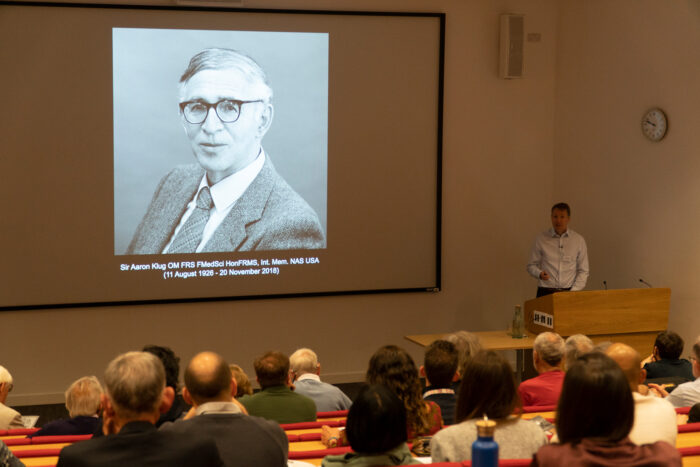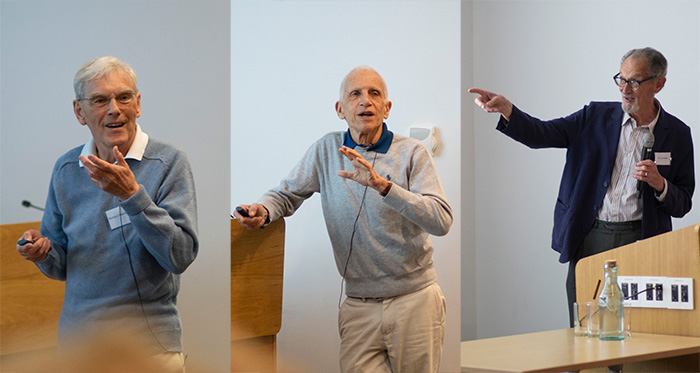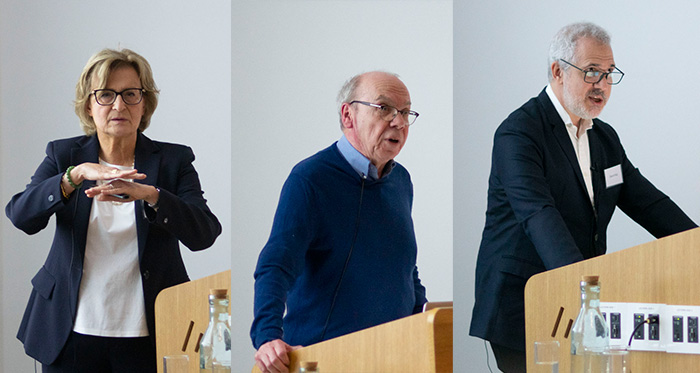
After a two-year postponement, the LMB recently welcomed alumni, colleagues, family and friends to the LMB to celebrate the life and work of Aaron Klug, with a symposium in his honour. Aaron, Nobel Laureate, former Director of the LMB and former President of The Royal Society, died on 20th November 2018.
The Symposium was opened by Jan Löwe, LMB Director: “As a biophysicist, Aaron made seminal contributions to structural biology, virology and chromatin biology and his work on the practical aspects and the theory of three-dimensional electron microscopy made major impacts within the field, but also as far afield as medicine.”
The programme included talks by many of Aaron’s former colleagues, scientists influenced by his work and his family: Tony Crowther, a long-term colleague, shared clips from an interview he did with Aaron in 2001, and commented: “I hope these serve as a reminder of Aaron for those who knew him, and an introduction for those who didn’t”. David DeRosier talked about the way 3D reconstruction came about – the steps that were involved, and where Aaron had a better idea: “Thus, the move from 2D to 3D came about because Aaron set out to solve the structures of viruses,” David concluded.

Richard Henderson, who took over from Aaron as LMB Director, covered the history of EM, from 1950, right up to the present day, and noted that: “Aaron wasn’t there at the beginning, and he wasn’t there at the end, but he had a very important role in the key steps forward, from the olden days to the modern times”. Steve Harrison highlighted how Aaron was continually moving on to different areas of research: “each of the things he [Aaron] moved on to, created both a new field – a platform for all of the rest of us to do useful work – but also created yet another pillar of the edifice of structural biology”.
Roger Kornberg, a postdoctoral researcher with Aaron who started studying the problem of chromatin at the LMB, commented: “Aaron thought it could be solved and he encouraged me to do it, encouraged me to pursue the problem”. Karolin Luger talked about the work on nucleosomes, and commented: “Pretty much a lot of things we now know about the nucleosome, were already known about in the ‘70s, thanks to work from, mainly, Aaron’s lab”.

Daniela Rhodes worked with Aaron on tRNA and chromatin: “I owe my career in science to Aaron” explained Daniela, “because I came across Aaron when I was very young, and from him I learnt how to go about asking scientific questions and how to do science”. Michel Goedert talked about the work on Alzheimer’s filaments, and commented: “Aaron was an important influence on my life. I remember well how pleased he was when he told Max Perutz that we had identified alpha-synuclein in the Lewy bodies of Parkinson’s disease”. He added, “The breadth and depth of his interests and knowledge was astounding”.
David Klug, Aaron’s son, concluded the talks with a personal view of his father, accompanied by family photos and anecdotes. This included David’s recollections of the LMB: “My father used to take me here from time to time and keep me occupied by various means … that was tremendous fun”. David highlighted Aaron’s other interests and skills, “he was actually more practical then he let on”, and beyond the day to day, “he had a toughness to him that people didn’t expect.”
In his closing remarks, Jan Löwe commented: “What’s been clear to me is that Aaron has been an intellectual giant, it’s obvious from what’s been published. He still has thousands of citations per year, ten years after he stopped doing active science, not many people match that. What I took away from today, is that he was clearly loved by very many people … and that is what really enabled him to be so outstandingly successful”.
The in-person attendees were also joined by over 100 online participants, from around the world, for the hybrid event.
A recording of the talks is now available below
Photo gallery
Further references
Aaron Klug (1926 – 2018)
Tony Crowther: Sir Aaron Klug OM. 11 August 1926 – 20 November 2018. Biographical Memoirs of Fellows of The Royal Society, 2020